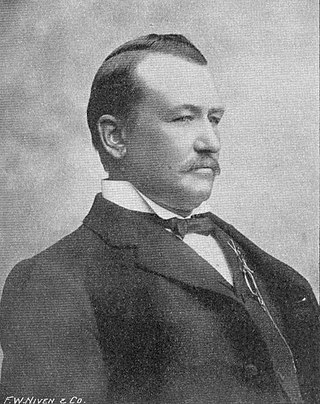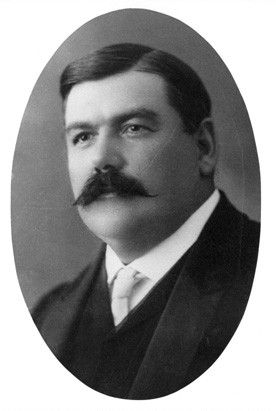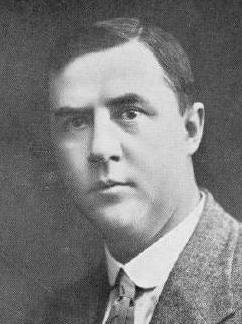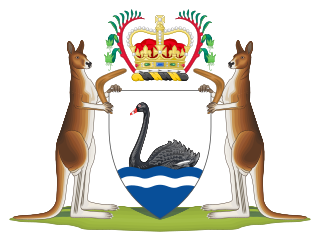Related Research Articles

Alfred Edward Morgans was the fourth Premier of Western Australia, serving for just over a month, from 21 November to 23 December 1901.

Major General Sir Newton James Moore, was an Australian politician, businessman and army officer. He served as the eighth Premier of Western Australia from 1906 to 1910 and, following service in the First World War, was a member of the House of Commons of the United Kingdom from 1918 to 1932. He was the father of Sir Rodney Moore.

Frank Wilson, was the ninth Premier of Western Australia, serving on two separate occasions – from 1910 to 1911 and then again from 1916 to 1917.

Edward Bertram Johnston, known as Bertie Johnston, was the Western Australian Legislative Assembly member for Williams-Narrogin from 1911 to 1928, and a Senator from 1929 until 1942. His resignation from the Australian Labor Party in 1915 made possible the defeat of John Scaddan's Labor government in Western Australia.

Sir Henry Bruce Lefroy was the eleventh Premier of Western Australia.
The Morgans Ministry was the fourth ministry of the Government of Western Australia, led by Alf Morgans of the Ministerialist faction. It succeeded the First Leake Ministry on 21 November 1901, and was followed by the Second Leake Ministry on 23 December 1901.

Elections were held in the state of Western Australia on 3 October 1911 to elect 50 members to the Western Australian Legislative Assembly. The Labor Party, led by Opposition Leader John Scaddan, defeated the conservative Ministerialist government led by Premier Frank Wilson. In doing so, Scaddan achieved Labor's first absolute majority on the floor of the Assembly and, with 68% of the seats, set a record for Labor's biggest majority in Western Australia. The record would stand for nearly 106 years until Labor won 69% of seats at the 2017 election. The result came as something of a surprise to many commentators and particularly to the Ministerialists, as they went to an election for the first time as a single grouping backed by John Forrest's Western Australian Liberal League, under a new system of compulsory preferential voting and new electoral boundaries both of which had been passed by Parliament earlier in the year despite ardent Labor opposition.
This is a list of members of the Western Australian Legislative Assembly between the 1901 election and the 1904 election, together known as the Fourth Parliament.
This is a list of members of the Western Australian Legislative Council from 22 May 1910 to 21 May 1912. The chamber had 30 seats made up of ten provinces each electing three members, on a system of rotation whereby one-third of the members would retire at each biennial election. Prior to the 1910 election, the Council had thought of itself as entirely independent from party politics, but with the election of Labor members to the Council and Labor's vigorous campaign at the 1911 election for the Legislative Assembly, many of its members joined the newly formed Liberal Party which had emerged from the various National Political Leagues and Liberal Leagues.
The Rason Ministry was the 8th Ministry of the Government of Western Australia and was led by Ministerialist Premier Hector Rason. It succeeded the Daglish Ministry on 25 August 1905 after the previous Labor minority administration fell on a vote of no confidence. On 7 May 1906, it was followed by the Moore Ministry led by Minister for Lands Newton Moore.
The Moore Ministry was the 9th Ministry of the Government of Western Australia and was led by Ministerialist Premier Newton Moore. It succeeded the Rason Ministry on 7 May 1906 after Rason resigned to accept an appointment as Agent-General for Western Australia in London. It was succeeded by the First Wilson Ministry on 16 September 1910 after Moore resigned for exactly the same reason.
The Scaddan Ministry was the 11th Ministry of the Government of Western Australia and was led by Labor Premier John Scaddan. It succeeded the First Wilson Ministry led by Ministerialist Frank Wilson on 7 October 1911 after the decisive result of the state election held four days earlier, which had produced the State's first majority Labor government.
The Second Wilson Ministry was the 12th Ministry of the Government of Western Australia and was led by Liberal Premier Frank Wilson. It succeeded the Scaddan Ministry on 27 July 1916 after a vote of no confidence passed in the Legislative Assembly, due mainly to the Labor Party losing its one-seat majority through a by-election and a member resigning from the party to become an independent. In early 1917, the Liberal Party was consumed by the Nationalist Party, to whom most of its members pledged their allegiance. Its leader, Sir Henry Lefroy, formed the Lefroy Ministry on 28 June 1917.
The Lefroy Ministry was the 13th Ministry of the Government of Western Australia and was led by Nationalist Premier Sir Henry Lefroy. It succeeded the Second Wilson Ministry on 28 June 1917 due to most members of the former Liberal Party, of which the previous Premier, Frank Wilson, had been the leader, pledging allegiance to the new party. The Lefroy Ministry, which was the first Coalition ministry in Western Australia, was also the only Ministry of a non-Labor government to be chosen by caucus.
The Colebatch Ministry was the 14th Ministry of the Government of Western Australia and was led by Nationalist Premier Hal Colebatch. It succeeded the Lefroy Ministry on 17 April 1919 after Sir Henry Lefroy's resignation as premier. Colebatch, a member of the Legislative Council and the first from that chamber to ever be asked to form a ministry, had the problem of finding a conveniently-located country seat which was not held by the Country Party. Before he could consolidate his leadership, his handling of the "Battle of the Barricades" on the waterfront severely damaged his standing and he stood aside. On 17 May 1919, the First Mitchell Ministry was formed by the Minister for Lands, James Mitchell.
The First Mitchell Ministry was the 15th Ministry of the Government of Western Australia and was led by Nationalist Premier James Mitchell. It succeeded the Colebatch Ministry on 17 May 1919 after the collapse of Hal Colebatch's brief service as Premier. It assumed a stability which had been absent from Western Australian politics since the 1914 election. The ministry was followed by the Collier Ministry on 15 April 1924 after the Nationalist coalition lost government at the state election held on 22 March.

The First Collier Ministry was the 16th Ministry of the Government of Western Australia and was led by Labor Premier Philip Collier. It succeeded the First Mitchell Ministry on 16 April 1924, following the defeat of the Nationalist government at the 1924 election on 22 March.
The Second Mitchell Ministry was the 17th Ministry of the Government of Western Australia and was led by Nationalist Premier Sir James Mitchell. It succeeded the First Collier Ministry on 23 April 1930, following the defeat of the Labor government at the 1930 election on 26 March.

The Minister for Education and Training is the member of the Government of Western Australia responsible for maintenance and improvement of Western Australia's system of education, and is answerable to the Parliament for all actions taken by the Department of Education under their authority. The holder of the office is usually an elected member of parliament from the ruling party or coalition, presently Tony Buti of the Labor Party.
Sydney Stubbs CMG was an Australian politician who served twice in the Parliament of Western Australia: in the Legislative Council from 1908 to 1911, and then in the Legislative Assembly from 1911 to 1947. He was Speaker of the Legislative Assembly from 1930 to 1933, and had been Mayor of Claremont and then Mayor of Perth prior to entering parliament.
References
- Black, David; Bolton, Geoffrey (2001). Biographical Register of Members of the Parliament of Western Australia, Volume One, 1870–1930 (Revised ed.). Parliament House: Parliament of Western Australia. ISBN 0730738140.
- de Garis, Brian (1991). "Self-Government and Political Parties". In Black, David (ed.). The House on the Hill: A History of the Parliament of Western Australia 1832–1990. Perth, Western Australia: Parliament of Western Australia. ISBN 0730939839.
- Bolton, Geoffrey; Mozley, Ann (1961). The Western Australian Legislature, 1870-1930. Canberra: Australian National University. (no ISBN)